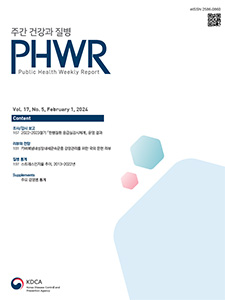Current Issue
Vol.17 No.5, February 01, 2024
-
Surveillance Reports 2024-02-01
 1
1
 376
376
 185
185
Results of the 2022–2023 「Winter Cold-Related Illness Surveillance」
Juhyun Lee, Daeshik An, Younjhin Ahn
Public Health Weekly Report 2024; 17(5): 167-180 https://doi.org/10.56786/PHWR.2024.17.5.1 Abstract
AbstractThe Korea Disease Control and Prevention Agency establishes a cold-related illness (CRI) surveillance system that monitors the occurrence of CRI (hypothermia, frostbite, chilblains, immersion disease, etc.) in approximately 500 medical institutions operating emergency rooms across the country every winter (December to February of the following year) is being operated. Collectively, 507 organizations participated in the CRI emergency room surveillance system for the 2022–2023 season (as of December 2022), and a total of 447 reported CRI patients (including 12 presumed CRI deaths) were reported, an increase of 49.0% (147 people) compared to the previous year. The national average temperature in the winter of 2022 (2022.12.–2023.2.) was 0.2℃ (–0.3℃ compared to average value over 30 years from 1971 to 2000), similar to the average temperature. In late January 2023, it was the lowest temperature during the winter and the largest number of CRIs (25.7%) occurred during the entire surveillance period (2022.12.–2023.2.). Most CRIs were reported by males (303 people, 67.8%), people over 80-year-old (102 people, 22.8%), and unemployed people (151 people, 33.8%). Occurrence times occur consistently throughout the day, but especially in the morning. 31.3% (140 people) of all patients occurred during the activity time period of 6 to 12 o’clock. The most common location of occurrence was along the road (111 people, 24.8%), followed by around residential areas (67 people, 15.0%), and at home (66 people, 14.8%). The most common CRI was hypothermia (300 patients, 67.1%), and 19.7% (88 patients) of all patients were drunk at the time of admission.
-
Review & Perspective 2024-02-01
 2
2
 603
603
 422
422
Review of International Literature for the Prevention and Control of Carbapenem-resistant Enterobacterales Infections
EunJo Kim, JaHyun Kang, Junghee Hyun, Sookkyung Park
Public Health Weekly Report 2024; 17(5): 181-196 https://doi.org/10.56786/PHWR.2024.17.5.2AbstractCarbapenem-resistant Enterobacterales (CRE) infection poses a significant global public health threat and is categorized as a class 2 notifiable infectious disease under national surveillance in the Republic of Korea. With an increasing trend in reported cases and the number of reporting medical institutions, the establishment of effective infection control measures is necessary to prevent the spread of CRE. Through extensive internet searches, we reviewed foreign CRE strategies and international health organizations’ guidelines on CRE infection control. As a result, we found that many advanced countries actively manage antibiotic resistance by establishing surveillance system databases. They collect and analyze data on CRE occurrences and patients’ clinical and diagnostic information at the government level, sharing specific CRE reporting criteria, management strategies, and guidelines. While pre-emptive isolation and disinfectant bathing are not included in Korean CRE infection control guidelines, these intervention strategies are recommended in international CRE guidelines. Future research needs to be conducted to assess their applicability and effectiveness in the Korean context, and practical plans should be formulated based on these findings to enhance the capacity to prevent and respond to CRE transmission.
-
QuickStats 2024-02-01
 0
0
 142
142
 188
188
Trends in the Prevalence of Perceived Stress, 2013–2022
Public Health Weekly Report 2024; 17(5): 197-198 https://doi.org/10.56786/PHWR.2024.17.5.3

pp. 1~2097
Most Keyword
?
What is Most Keyword?
- It is the most frequently used keyword in articles in this journal for the past two years.
Most Read
-
Waterborne and Foodborne Disease Outbreaks in the Republic of Korea, 2023
Myung-Jae Hwang, So Yeon Park, Hyungjun Kim, Se Jeong Yang, Sungchan Yang, Jin Seon Yang
Public Health Weekly Report 2025;18: 17-32 https://doi.org/10.56786/PHWR.2025.18.1.2 -
Implementation Plan for the Coronavirus Disease 2019 Vaccination for the 2024–2025 Season: Recommendations of the 6th Expert Committee on Immunization Practices
Hyewook Hwang, Wookeon Lee, Seohyeon Ahn, Young-Sook Choi, Seunghyun Lewis Kwon, Dongwoo Lee, Eun Hwa Choi, SokGoo Lee
Public Health Weekly Report 2025;18: 90-102 https://doi.org/10.56786/PHWR.2025.18.2.3
Editorial Office
+82-43-719-7569





 Full Text
Full Text Cite
Cite


